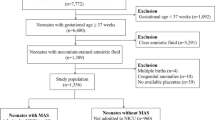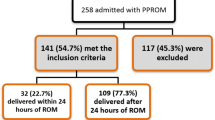Abstract
Catecholamine levels and associated cardiovascular responses were determined in 21 control and 30 term infants with meconium-stained amniotic fluid (MSAF). Cord arterial blood was obtained for determination for norepinephrine (NE) and epinephrine (EPI) levels; cardiovascular measurements included heart rate and systolic blood pressure at 30 min. Pregnancy was uncomplicated in all cases. The total length of labor 964±402 versus 555±312 min (P<0.001) and active phase of labor 300±261 versus 135±104 min (P<0.001) were significantly longer in MSAF infants when compared to controls. The 1 min Apgar score was <7 (range 1–6) in 11 of 30 MSAF infants versus 0 of 21 control infants; these 11 infants required positive pressure ventilation for approximately 60 s secondary to transient respiratory depression (RD). The 5 min Apgar score was >7 in 49 of the 51 infants. Infants with MSAF exhibited a higherP aCO2 (6.89±1.17 vs 6.24±1.17 mm Hg;P<0.02) and lower pH (7.25±0.06 vs 7.29±0.05;P<0.02) compared to controls. Infants with transient RD demonstrated the most marked arterial blood gas differences, i.e.,PCO2 7.41±1.30 mm Hg (P<0.001), pH 7.21±0.07 (P<0.001) and base deficit −6±4 versus −3±2.8 (P<0.001) when compared to controls. NE and EPI levels were significantly higher in MSAF versus control infants, i.e., 12600±3040 versus 3740±1000 pg/ml (SEM) (P<0.02) and 1550±250 versus 620±130 pg/ml (P<0.001) respectively. The highest values were observed in infants with transient RD. NE levels were related to base deficit (r=−0.45,P<0.0001) and the presence of meconium (r=0.26,P<0.05), while EPI levels were related to pH (r=0.44,P<0.001) and meconium (r=0.28,P<0.05). MSAF infants exhibited a higher systolic blood pressure at 30 min, i.e., 59±10 versus 54±8 mm HgP<0.002 when compared to controls. No differences in heart and respiratory rates were noted. These data indicate that infants delivered in the presence of MSAF exhibit significant elevations in catcholamine levels when compared to control infants, which may reflect an adaptive respone to in utero stress.
Similar content being viewed by others
References
Abramovici H, Brandes J, Fuchs K, Timor-Tritsch I (1974) Meconium during delivery: a sign of compensated fetal distress. Am J Obstet Gynecol 118:251–255
Behrman R, Lees M, Peterson E (1970) Distribution of the circulation in normal and asphyxiated fetal primate. Am J Obstet Gynecol 108:856–869
Bistoletti P, Langercrantz H, Lunell NO (1980) Correlation of fetal heart rate patterns with umbolical artery pH and catecholamines during last hour of labor. Acta Obstet Gynecol Scand 59:213–216
Cohen W, Piasecki G, Cohn H, Jackson B (1987) Plasma catecholamines in the hypoxemic rhesus monkey. J Dev Physiol 9:507–515
Cohn H, Sacks E, Heymann M, Rudolph A (1974) Cardiovascular responses to hypoxemia and acidemia in fetal lambs. Am J Obstet Gynecol 120:187–195
Comline R, Silber M (1966) Development of activity in the adrenal medulla of the foetus and newborn animal. Br Med Bull 22:16–20
DeVane G, Porter J (1980) An apparent stress-induced release of arginine vasopressin by human neonates. J Clin Endocrinol Med 51:1412–1416
Eliot R, Lagercrantz H, Leake R, Hobel C, Fisher P (1980) Plasma catecholamine concentration in infants at birth and during the first 48 hours of life. J Pediatr 96:311–316
Falconer A, Lake D (1982) Circumstances influencing umbilical cord plasma catecholamines at delivery. Br J Obstet Gynecol 9:44–50
Faxelius E, Lagercrantz H, Yao A (1984) Sympathoadrenal activity and peripheral blood flow after birth: comparison in infants delivered vaginally and by cesarean section. J Pediatr 105:144–148
Fenton A, Steer C (1962) Fetal distress: Am J Obstet Gynecol 83:354–362
Fujikura T, Klionsky B (1975) The significance of meconium staining. Am J Obstet Gynecol 121:45–50
Gregory G, Gooding C, Phibbs R, Fooley W, et al (1974) Meconium aspiration in infants — a prospective study. J Pediatr 85:848–852
Harris A, Koehler R, Gleason C, et al (1989) Cerebral and peripheral circulatory responses to intracranial hypertension in fetal sheep. Circ Res 64:991–1000
Hobel C (1971) Intrapartum clinical assessment of fetal distress. Am J Obstet Gynecol 110:336–342
Irestedt L, Lagercrantz H, Hjemdahl P, Hagnevik K, Belfrage P (1982) Fetal and maternal plasma catecholamine levels at elective cesarean section under general or epidural anesthesia versus vaginal delivery. Am J Obstet Gynecol 142:1004–1010
Johnson G, Kupiecki R, Baker C (1980) Single isotope derivative (radioenzymatic) methods in the measurement of catecholamines. Metabolism 29:1106–1113
Lagercrantz H, Bistoletti P (1977) Catecholamine release in the newborn. Pediatr Res 11:889–893
Lewis A, Evans W, Sischo W (1982) Plasma catecholamine responses to hypoxemia in fetal lambs. Biol Neonate 41:115–122
Meis P, Hall M, Marshall J, Hobel C (1978) Meconium passage: a new classification for risk assessment during labor. Am J Obstet Gynecol 131:509–514
Miller F, Sacks D, Yeh S, et al (1975) Significance of meconium during labor. Am J Obstet Gynecol 122:573–580
Mitchell J, Shulman H, Fleischer A, et al (1985) Meconium aspiration and fetal acidosis. Obstet Gynecol 65:352–355
Nakai T, Yamada R (1978) The secretion of catecholamines in newborn babies with special reference to fetal distress. J Perinat Med 6:39–45
Nylund L, Dahlin L, Lagercrantz H (1987) Fatal catecholamine and the Apgar score. K Perinat Med 15:340–344
Parer JT (1984) Fetal heart rate. Saunders, Philadelphia
Passon P, Peuller J (1973) A simplified radioactive assay for plasma norepinephrine and epinephrine. Anal Biochem 618–631
Paulick R, Kastendieck E, Wernze H (1985) Catecholamines in arterial and venous umbilical blood: placental extraction, correlation with fetal hypoxia and transcutaneous oxygen tension. J Perinat Med 13:31–42
Paulick R, Schwab O, Kastendieck, Wernze H (1988) Plasma free and sulfoconjugated catecholamines during acute asphyxia in the sheep fatus — relation to cardiovascular parameters. J Perinat Med 16:113–121
Peeters L, Sheldon R, Jones M, Makowski E, Meschia G (1979) Blood flow to fetal organs as a function of arterial oxygen content. Am J Obstet Gynecol 135:637–645
Schifrin BS (1989) The diagnosis and treatment of fetal distress. Raven Press, New York
Shah S, Clutter W, Cryer P (1985) External and internal standards in the single isotope derivative (radio enzymatic) assay of plasma nonepinephrine and epinephrine in normal human and persons with diabetes or chronic renal failure. J Lab Clin Med 1061:624–629
Starks G (1980) Correlation of meconium stained amniotic fluid, early intrapartum fetal pH and Apgar scores as predictors of perinatal outcome. Obstet Gynecol 56:604–609
Usher R, Boyd M, McLean F, et al (1988) Assessment of fetal risk in postdate pregnancies. Am J Obstet Gynecol 158:259–265
Walker J (1954) Fetal anoxia. J Obstet Gynaecol Br Emp 61: 162–80
Wiswell T, Tuggle J, Turner B (1990) Meconium aspiration syndrome: Have we made a difference? Pediatrics 85:715–721
Yeomans E, Hauth J, Gilstrap L, Strickland D (1985) Umbilical cord pH, pCO2 and bicarbonate following uncomplicated term vaginal deliveries. Am J Obstet Gynecol 151:798–801
Yeomans E, Gilstrap L, Leveno K, Burris J (1989) Meconium in the amniotic fluid and fetal and acid-base status. Obstet Gynecol 73:175–178
Author information
Authors and Affiliations
Rights and permissions
About this article
Cite this article
Garcia-Alix, A., Perlman, J.M. & Amon, E. Catecholamine levels and associated cardiovascular responses in infants with meconium-stained amniotic fluid. Eur J Pediatr 151, 855–860 (1992). https://doi.org/10.1007/BF01957940
Received:
Accepted:
Issue Date:
DOI: https://doi.org/10.1007/BF01957940




